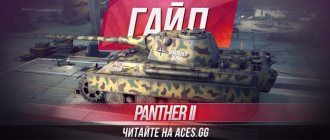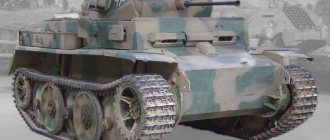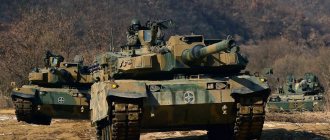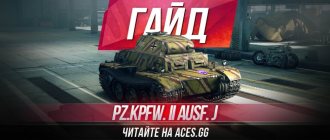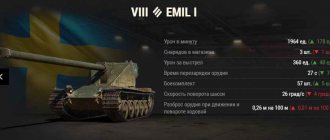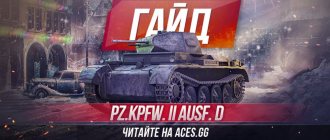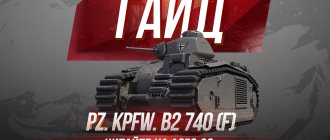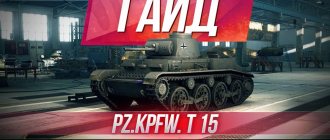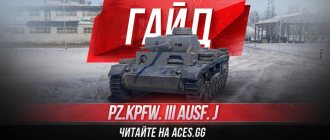Good day to all World of Tanks players and fans of German technology! Now we will talk about a rather rare vehicle, a medium premium tank of the fifth level and this is the Pz.Kpfw. V/IV guide or as it is more often called – Pz. V/IV.
This device in patch 0.9.15 was transferred from the sixth level to the fifth and underwent a number of changes. In addition, this vehicle is a rare guest in battles because it can only be purchased through the premium store on the WoT website, and even then not always, only on holidays and during certain promotions.
TTX Pz. V/IV
Paying attention to Pz. V/IV characteristics can say a lot. Firstly, we have a good margin of safety for the fifth level and simply excellent mobility, especially if you pay attention to the considerable weight. The tank is really quite fast, reaches maximum speed in a matter of seconds, and also has good maneuverability.
Secondly - Pz. V/IV WoT is a bizarre combination of two different German vehicles, we got the hull from a panther, and the turret from a level 4 panzer. Thus, our frontal hull armor for the fifth level is quite good; we can repel shells from same-level and even smaller enemies very well. In addition, there are screens around the turret and along the side of the hull, which allows you to periodically eat cumulative shells. Besides everything else, this German’s review is also good, and besides, we can still install modules and upgrade the crew.
DESIGN DESCRIPTION
DESIGN DESCRIPTION
TANK LAYOUT - classic, with a front-mounted transmission.
The control compartment was located in front of the combat vehicle. It housed the main clutch, gearbox, turning mechanism, controls, control instruments, a forward machine gun (with the exception of modifications B and C), a radio station and workplaces for two crew members - the driver and the gunner-radio operator.
The fighting compartment was located in the middle part of the tank. Here (in the turret) there was a cannon and a machine gun, observation and aiming devices, vertical and horizontal aiming mechanisms and seats for the tank commander, gunner and loader. The ammunition was placed partly in the turret and partly in the hull.
In the engine compartment, at the rear of the tank, there was an engine and all its systems, as well as an auxiliary engine for the turret rotation mechanism.
hull was welded from rolled armor plates with surface cementation, generally located at right angles to each other.
Layout of the Pz.IV tank: 1 - turret; 2 — commander’s cupola; 3 — box for equipment; 4 — rotating floor of the fighting compartment; 5 — fans; 6 - engine; 7 — fan drive pulley; 8 — exhaust manifold; 9 — muffler for turret rotation engine; 10 — muffler; 11 — guide wheel; 12— suspension trolley; 13 — cardan shaft; 14 — gearbox; 15 — gear shift link; 16 - drive wheel.
In the front part of the roof of the turret box there were manholes for the driver and gunner-radio operator, which were closed with rectangular covers that hinged. Modification A has double-leaf lids, while the others have single-leaf lids. Each cover had a hatch for launching signal flares (with the exception of options H and J).
In the frontal plate of the hull on the left there was a driver's viewing device, which included a triplex glass block, closed by a massive armored sliding or folding shutter Sehklappe 30 or 50 (depending on the thickness of the frontal armor), and a binocular periscope observation device KFF2 (y Ausf.A - KFF1). The latter, when there was no need for it, moved to the right, and the driver could observe through the glass block. Modifications B, C, D, H and J did not have a periscope device.
On the sides of the control compartment, to the left of the driver and to the right of the gunner-radio operator, there were triplex viewing devices, covered with hinged armored covers.
There was a partition between the rear of the hull and the fighting compartment. There were two hatches in the roof of the engine compartment, closed with hinged covers. Starting from Ausf.Fl, the covers were equipped with blinds. In the reverse slope of the left side there was an air supply window to the radiator, and in the reverse slope of the right side there was an air exhaust window from the fans.
Reservation scheme for the Pz.IV medium tank.
Turret of the Pz.IV Ausf.A tank. It should be noted that during serial production the configuration of the tower has remained virtually unchanged.
TURRET - welded, hexagonal, mounted on a ball bearing on the turret plate of the hull. In its front part, in the mask, there was a cannon, a coaxial machine gun and a sight. To the left and right of the mask there were observation hatches with triplex glass. The hatches were closed with external armored flaps from inside the turret. Starting with modification G, the hatch to the right of the gun was missing.
The tower was driven by an electromechanical turning mechanism with a maximum speed of 14 degrees/s. A full revolution of the tower was carried out in 26 s. The flywheels of the turret's manual drive were located at the gunner's and loader's workstations.
At the rear of the tower roof there was a commander's cupola with five viewing slots with triplex glass. From the outside, the viewing slots were closed with sliding armor flaps, and the hatch in the turret roof, intended for the tank commander to enter and exit, was closed with a double-leaf lid (later - single-leaf).
Turret of the Pz.IV Ausf.D tank without weapons.
Turret of the Pz.IV Ausf.J tank. On the front of the commander's cupola there is a bracket for mounting an anti-aircraft machine gun.
The turret had a dial-hour type device for determining the target location. A second similar device was at the gunner’s disposal and, having received an order, he could quickly turn the turret towards the target. At the driver's seat there was a turret position indicator with two lights (except for Ausf.J tanks), thanks to which he knew what position the turret and gun were in (this is especially important when driving through wooded areas and populated areas).
For boarding and disembarking crew members, there were hatches on the sides of the turret with single-leaf and double-leaf (starting with version F1) covers. Inspection devices were installed in the hatch covers and sides of the tower. The turret's rear plate was equipped with two hatches for firing personal weapons. On some vehicles of modifications H and J, due to the installation of screens, inspection devices and hatches were missing.
Interior view of the commander's cupola. In the top photo the viewing devices are in the open position, and in the bottom photo they are in the closed position.
Installation of a 75 mm KwK 37 (L/24) gun.
WEAPONS . The main armament of tanks of modifications A - F1 is a 7.5 cm KwK 37 cannon of 75 mm caliber from Rheinmetall-Borsig. The length of the gun barrel is 24 caliber (1765.3 mm). The weight of the gun is 490 kg. Vertical aiming - ranging from -10° to +20°. The gun had a vertical wedge breech and an electric trigger. Its ammunition included shots with smoke (weight 6.21 kg, initial speed 455 m/s), high-explosive fragmentation (5.73 kg, 450 m/s), armor-piercing (6.8 kg, 385 m/s) and cumulative (4.44 kg, 450...485 m/s) projectiles.
Ausf.F2 tanks and some Ausf.G tanks were armed with a 7.5 cm KwK 40 cannon with a barrel length of 43 calibers (3473 mm), weighing 670 kg. Some Ausf.G tanks and Ausf.H and J vehicles were equipped with a 7.5 cm KwK 40 cannon with a barrel length of 48 calibers (3855 mm) and a weight of 750 kg.
Interior of the turret of the Pz.IV Ausf.E tank. The gun breech, coaxial machine gun, gun guard and turret fan are clearly visible.
Interior of the turret of the Pz.IV Ausf.E tank. The gun guard, forehead and eyepiece of the telescopic sight and the flywheel of the lifting mechanism are clearly visible.
Vertical aiming -8°… +20°. The maximum rollback length is 520 mm. During the march, the gun was fixed at an elevation angle of +16°.
A 7.92-mm MG 34 machine gun was paired with the cannon. The forward machine gun was placed in the front plate of the turret box in a ball mount (except for modifications B and C). On the commander's cupola of the later type, an MG 34 anti-aircraft machine gun could be mounted on a special device Fliegerbeschutzgerat 41 or 42.
Pz.IV tanks were initially equipped with the TZF 5b monocular telescopic sight, and starting with the Ausf.E - TZF 5f or TZF 5f/l. These scopes had 2.5x magnification. The MG 34 course machine gun was equipped with a 1.8x KZF 2 telescopic sight.
Depending on the modification of the tank, the gun's ammunition ranged from 80 to 122 rounds. For command tanks and forward artillery observer vehicles it was 64 rounds. Machine gun ammunition - 2700...3150 rounds.
Interior of the Pz tank turret. IV Ausf.G. Compared to tanks armed with short-barreled guns, nothing has changed in the interior of the turret (photo above). The picture in the center shows the installation of an MG 34 machine gun on the commander's cupola bracket. Judging by the photo below, this machine gun was intended not so much for firing at air targets as for self-defense.
The table is compiled based on German sources.
Comparative sizes of two shots: the RaK 40 anti-tank gun (left) and the KwK 40 tank gun. Contrary to popular belief, they are not interchangeable.
ENGINE AND TRANSMISSION . The tank was equipped with Maybach HL 108TR, HL 120TR and HL 120TRM engines, 12-cylinder, V-shaped (cylinder camber - 60°), carburetor, four-stroke, with a power of 250 hp. (HL108) and 300 hp (Hb 120) at 3000 rpm. Cylinder diameters are 100 and 105 mm. Piston stroke 115 mm. Compression ratio 6.5. Displacement volume 10,838 cm3 and 11,867 cm3. It should be emphasized that both engines were of a similar design.
Fuel is leaded gasoline with an octane rating of at least 74. The capacity of three gas tanks is 420 l (140+110+170). Ausf.J tanks had a fourth fuel tank with a capacity of 189 liters. Fuel consumption per 100 km when driving on the highway is 330 liters, off-road - 500 liters. The fuel supply is forced, using two Solex fuel pumps. There are two carburetors, Solex 40 JFFII.
The cooling system is liquid, with one radiator located obliquely on the left side of the engine. There were two fans on the right side of the engine.
Engine Maybach HL 108TR.
T-IVF2.Pz.IV Ausf.F2.
On the right side of the engine, a DKW PZW 600 (Ausf.A - E) or ZW 500 (Ausf.E - H) engine for the turret rotation mechanism with a power of 11 hp was installed. and a working volume of 585 cm3. The fuel was a mixture of gasoline and oil, the fuel tank capacity was 18 liters.
The transmission consisted of a cardan drive, a three-disc main dry friction clutch, a gearbox, a planetary rotation mechanism, final drives and brakes.
The five-speed Zahnradfabrik SFG75 (Ausf.A) gearbox and the six-speed SSG76 (Ausf.B - G) and SSG77 (Ausf.H and J) are three-shaft, with coaxial drive and driven shafts, with spring disk synchronizers.
Maxbach HL 120TRM engine cooling diagram: 1 — air outlet windows; 2 — folding fan unit; 3 — cooling system pipelines; 4 - radiator; 5 — air supply windows.
This type of guide wheel was used on tanks of modifications from F1 to H (left), and this one was used on vehicles of modification J (right).
's chassis , applied to one side, consisted of eight double rubber-coated road wheels with a diameter of 470 mm, interlocked in pairs into four balance bogies, suspended on quarter-elliptical leaf springs; four (for part of Ausf.J - three) dual rubber-coated (except for Ausf. J and part of Ausf.H) support rollers.
The front drive wheels had two removable ring gears of 20 teeth each. Pin engagement.
The caterpillars are steel, fine-linked, made of 101 (starting from version F1 - 99) single-ridge tracks each. The track width is 360 mm (up to option E), and then 400 mm.
ELECTRICAL EQUIPMENT was made according to a single-wire circuit. Voltage 12 V. Sources: Bosch GTLN 600/12-1500 generator with a power of 0.6 kW (Ausf.A has two Bosch GQL300/12 generators with a power of 300 kW each), four Bosch batteries with a capacity of 105 Ah. Consumers: Bosch BPD 4/24 electric starter with a power of 2.9 kW (Ausf.A has two starters), ignition system, tower fan, control devices, sight illumination, sound and light signaling devices, internal and external lighting equipment, sound signal, descents of cannon and machine guns.
MEANS OF COMMUNICATION . All Pz.IV tanks were equipped with a Fu 5 radio station, with a range of 6.4 km for telephone and 9.4 km for telegraph.
gun
Turning our attention to Pz. V/IV gun, we notice that everything is not as cool as with the general characteristics, but not bad at all. The gun has frankly few weaknesses. Our one-time damage is small, but look at the rate of fire! In total, these two indicators give approximately 1800 damage per minute, the result is excellent.
The armor penetration at our disposal is decent, but the trick is that the Pz. V/IV throws into battles no higher than level 6, which means that in case of emergency we should have gold shells with us, and there will be fewer problems. Although in most cases, with proper skill, you can simply use good speed and dynamics to drive into the enemy’s stern or side, where even ordinary shells will cope.
Regarding the comfort of shooting from a gun, everything is quite decent, we get down to it quickly, no one has canceled German accuracy, for these reasons for the Pz. V/IV WoT is suitable at any distance, and targeting a weak spot in the enemy’s armor will not be difficult.
What can I say, this tank even tilts its gun down by as much as 10 degrees, which is more than enough for a comfortable game on almost any map.
Tactics for playing Pz V/IV
It's time to touch on the most important topic, the nuances of playing Pz. V/IV combat tactics. From the very beginning of the battle until its end, we make maximum use of one of the main advantages of this machine - speed. High mobility provides a huge springboard for action; we can easily change flanks, directions of attack, and support our allies, both in attack and defense. However, we should not get into the thick of things, although our armor is not bad, our dimensions are very impressive, we can become an easy target for superior enemy forces, and the safety margin must be protected.
All actions need to be weighed, firing from behind the backs of the allies or at long distances will allow German precision, and the high rate of fire provides the opportunity for superiority over a large number of opponents in a serious confrontation. We can set fire to tanks, crit modules, and take out ammunition if we target vulnerable spots.
In other words, Pz. V/IV is a very playful and fun car, in the right hands it can do a lot, especially when we are at the top of the list. The question is Pz. Whether V/IV is worth taking is obvious; if you have such an opportunity, take it, you won’t regret it.
Memory of a tank
The PzKpfw IV was produced very en masse, so many of its modifications, especially the later ones, are presented in various museums around the world:
- Belgium, Brussels – Museum of the Royal Army and Military History, PzKpfw IV Ausf J;
- Bulgaria, Sofia - Museum of Military History, PzKpfw IV Ausf J;
- UK – Duxford War Museum and Bovington Tank Museum, Ausf. D;
- Germany – Museum of Technology in Sinsheim and Tank Museum in Munster, Ausf G;
- Israel – Israel Defense Forces Museum in Tel Aviv, Ausf. J, and the Israeli Armored Forces Museum in Latrun, Ausf. G;
- Spain, El Goloso – Museum of Armored Vehicles, Ausf H;
- Russia, Kubinka – Armored Museum, Ausf G;
- Romania, Bucharest – National War Museum, Ausf J;
- Serbia, Belgrade – Military Museum, Ausf H;
- Slovakia – Museum of the Slovak Uprising in Banska Bystrica and the Museum of the Carpathian-Dukele Operation in Svidnik, Ausf J;
- USA - Military Vehicle Technology Foundation Museum in Portola Valley, Ausf. H, US Army Armament Museum at Fort Lee: Ausf. D, Ausf. G, Ausf. H;
- Finland, Parola – Tank Museum, Ausf J;
- France, Saumur – Tank Museum, Ausf J;
- Switzerland, Thun – Tank Museum, Ausf H.
Pz.Kpfw.IV In Kubinka
